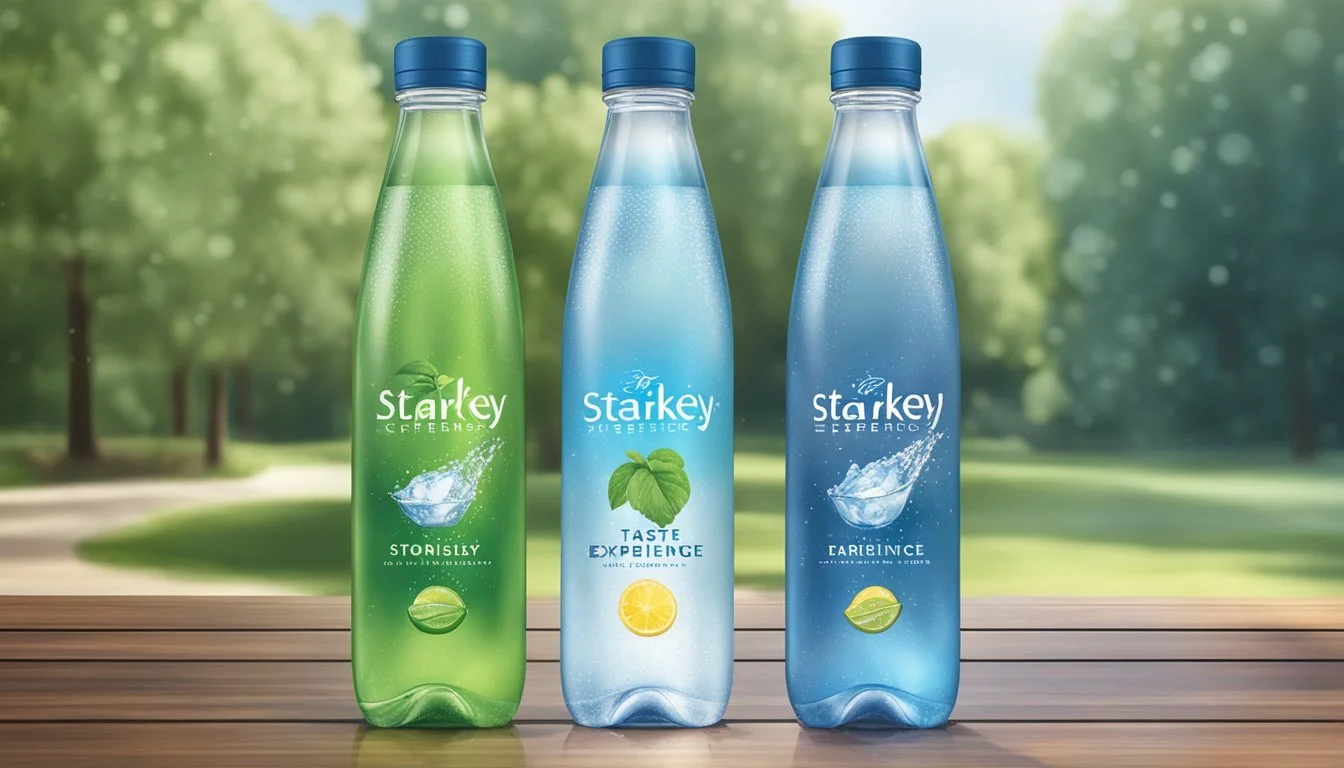Starkey vs. Action
Which Bottled Water is Better for Health and Taste?
When it comes to bottled water, Starkey and Action offer distinct experiences for consumers. Starkey, owned by Whole Foods Market, is known for its rich mineral content and refreshing taste, appealing to those who value mineral-rich hydration. On the other hand, Action emphasizes pure, clean water, ensuring every sip meets stringent quality standards.
For those seeking a mineral-rich option, Starkey stands out as the better choice, while for purists prioritizing cleanliness and consistency, Action takes the lead. By understanding the strengths of each brand, consumers can make an informed decision that best suits their hydration needs.
Each bottle carries its unique profile, making the simple act of choosing water more than just a matter of taste. As readers dive deeper into this comparison, they'll find the bottled water that perfectly matches their preferences and lifestyle.
Comparing Starkey and Action Bottled Waters
In comparing Starkey and Action bottled waters, it is essential to understand each brand's unique profile and the source of their water. This includes their history and the nature of their water sources.
Brand Profiles
Starkey is a product owned by Whole Foods Market. It sources its water from a geothermal spring in Idaho that is known for its purity and natural minerals. Starkey prides itself on providing naturally alkaline water with a pH level of 9.6.
Action Water is a newer entrant in the bottled water market. It emphasizes cutting-edge filtration processes and consistent quality. The brand aims to offer purified water free from contaminants, leveraging advanced purification technology to ensure a clear taste.
Both brands cater to different preferences: Starkey focuses on natural spring water with inherent minerals, appealing to those who prefer a natural source, while Action targets consumers looking for rigorously purified water.
Source and Origin
Starkey sources its water from a geothermal spring located in Idaho. This spring water is naturally alkaline, boasting a higher pH level which some consumers believe provides additional health benefits. The water is bottled at the source, ensuring minimal processing and maintaining its natural mineral content.
Action Water, on the other hand, takes a more technological approach. Its water undergoes multiple stages of filtration, including reverse osmosis and UV treatment. This ensures that any contaminants are eliminated, offering a highly purified product. The source of Action Water is typically municipal supplies, but the extensive filtration process distinguishes the final product from regular tap water.
Starkey's water retains natural characteristics from its geothermal origin, while Action Water prioritizes purity through advanced filtration techniques. This fundamental difference in sourcing and processing methods highlights the distinct approaches each brand employs to meet consumer demands for quality bottled water.
Quality and Purity Assessments
Evaluating the quality and purity of Starkey and Action bottled water involves examining their purification processes and independent testing results to ensure they meet safety standards and are free from contaminants.
Water Purification Processes
Starkey bottled water employs a multi-stage purification process. It is sourced from geothermal springs and undergoes filtration to remove sediments and particulates. The water is then treated to eliminate bacteria and viruses, ensuring it meets FDA safety standards.
Action uses advanced reverse osmosis. This method effectively filters out heavy metals, including lead, and other contaminants. The purified water is also subjected to UV treatment to destroy any remaining microorganisms. The company claims this ensures high purity and safety for consumers.
Independent Testing Results
Starkey water has been subject to scrutiny due to elevated levels of arsenic in the past. However, recent tests show it complies with federal limits. Consumer Reports mentions that while Starkey's arsenic levels are within legal limits, they still warrant caution among sensitive populations.
Action's independent testing results reveal consistently low levels of contaminants. Tests show that heavy metals and other harmful substances are effectively removed. Consumer Reports' tests on Action bottled water confirm that it ranks well in terms of purity, with no significant safety concerns detected.
These detailed assessments highlight the significance of rigorous water purification and constant testing to ensure safety and purity in bottled water brands.
Health and Hydration Benefits
Starkey and Action bottled waters offer distinct benefits when considering their health aspects and hydration properties. This section will explore their nutritional analysis and comparative health impacts.
Nutritional Analysis
Starkey water is sourced from geothermally heated springs and boasts a high mineral content, including electrolytes such as sodium, calcium, and magnesium. These minerals can enhance hydration by aiding fluid balance within the body.
Action water, on the other hand, is marketed primarily as purified water with added electrolytes for taste. It generally contains lower levels of naturally occurring minerals compared to Starkey, which may appeal to those seeking a less mineral-dense option.
A quick comparison:
Nutrient Starkey Action Sodium (mg/L) 30-35 10-20 Calcium (mg/L) 10-15 5-10 Magnesium (mg/L) 5-10 2-5
Both brands provide hydration, but Starkey's higher natural mineral content may offer added benefits for those needing more electrolytes.
Comparative Health Impacts
The health impacts of Starkey and Action bottled waters differ due to their source and mineral content. Starkey's minerals like calcium and magnesium contribute to bone health and muscle function. Its natural origin might be preferable for those seeking organic hydration sources.
Action water provides hydration with added electrolytes tailored for taste and is typically more affordable. It's suitable for individuals who prefer a cleaner, less mineral-heavy flavor profile.
Both types are free from harmful contaminants, making them safe for regular consumption. The choice between them depends significantly on individual preferences for mineral content and taste.
Taste Experience
Each bottled water offers a unique taste experience influenced by various factors, such as mineral content and source location. Starkey and Action are no different, standing out for distinct reasons.
Flavor Profiles
Starkey features a rich mineral content that provides a slightly saline and almost savory taste. The thick mouthfeel sets it apart from typical bottled waters. Some find this unique flavor intriguing, making it a polarizing choice among consumers.
Action, in contrast, boasts a clean and crisp taste with a neutral profile. Its minimal mineral content and balanced pH make it refreshing and appealing to those who prefer a subtler water flavor without any distinctive aftertaste.
Professional Assessments
Water sommeliers and experts have diverse opinions on Starkey. They appreciate its complex mineral composition, which contributes to its unique taste. However, this complexity may not suit everyone’s palate, as it can be perceived as too bold for a standard drink.
On the other hand, Action has garnered positive assessments for its straightforward, clean taste. Professionals commend its refreshing quality and smooth finish, noting its suitability for a wide audience who seek a less intrusive flavor in their bottled water.
Consumer Perception and Brand Loyalty
The choice between Starkey and Action bottled water is influenced by how consumers perceive these brands and their loyalty towards them. Factors like customer reviews and market presence play crucial roles in shaping these perceptions.
Customer Reviews and Feedback
Starkey is often praised for its crisp taste and high mineral content. Consumers report feeling refreshed and find the taste superior compared to other brands. Despite higher prices, loyal customers appreciate the perceived quality.
Action garners positive reviews for its purity and affordability. Many appreciate its clean, unadulterated taste, which appeals to those seeking a straightforward hydration option. Customer feedback frequently highlights its value for money and reliable availability in various stores.
Market Presence and Popularity
Starkey has a significant market share in premium grocery stores and health-focused outlets. Its marketing emphasizes natural sources and mineral-rich content, appealing to health-conscious consumers. Starkey’s strategic placement in niche markets contributes to its loyal customer base.
Action enjoys widespread availability in both grocery and convenience stores, making it a popular choice for everyday hydration needs. Its affordability and extensive distribution network boost its market presence. As a result, Action often becomes a go-to brand for budget-conscious consumers seeking accessible bottled water options.
Packaging and Environmental Impact
Packaging choices and the resulting environmental impact are critical factors when comparing Starkey and Action bottled waters.
Bottle Materials and Sustainability
Starkey utilizes glass bottles, which are known for their recyclability and minimal environmental contamination. Glass can be recycled indefinitely without loss in quality, making it a sustainable choice.
Action, on the other hand, uses PET plastic bottles. PET is recyclable, but its recycling rate is not as high as glass. Plastic waste, especially from single-use bottles, poses significant environmental challenges.
While both companies aim for sustainability, the materials they choose significantly impact their environmental footprint.
Brand Environmental Policies
Starkey emphasizes a commitment to health-conscious consumers through transparent environmental policies. Owned by Whole Foods Market, their sustainability measures include sourcing water responsibly and using eco-friendly packaging.
Action focuses on reducing its carbon footprint through initiatives like lightweighting their PET bottles and increasing the use of recycled materials. They have also invested in community recycling programs.
Both brands aim to mitigate their environmental impact, but their methods and effectiveness vary.
Pricing and Value Proposition
When comparing Starkey and Action bottled waters, it's vital to assess their pricing and value for money. Each brand offers different attributes that justify their costs.
Cost Comparison
Starkey is generally positioned as a premium bottled water, often found in specialty stores and high-end markets. Prices for Starkey can range from $2 to $3 per bottle. This premium pricing reflects its purported benefits, including its origin from geothermal springs, which is marketed as a unique selling point.
Action bottled water, on the other hand, is generally more affordable. Typically retailing for $1 to $1.50 per bottle, it targets the mass market. The lower price point makes it a more accessible choice for everyday use, competing on affordability rather than exclusivity.
In terms of value for money, Starkey's higher price is justified by its unique features and marketing, while Action offers practicality and budget-friendliness.
More About Starkey
Icelandic Glacial vs Starkey: Which Bottled Water is Better?
Mountain Valley Spring Water vs Starkey: Which Bottled Water is Better?
Starkey vs Kirkland Signature: Which Bottled Water is Better?
Starkey vs Richard's Rainwater: Which Bottled Water is Better?
Starkey vs Whole Foods Italian Still Mineral water: Which Bottled Water is Better?






